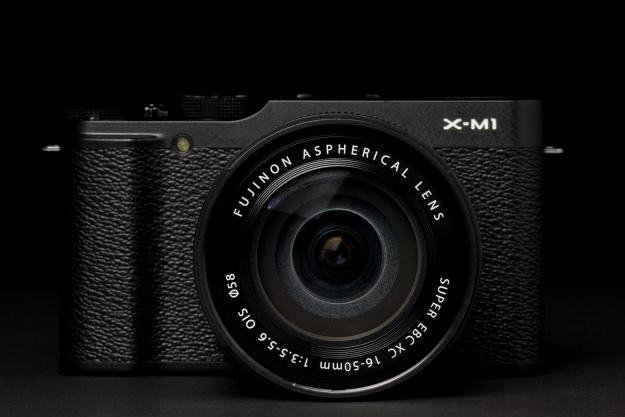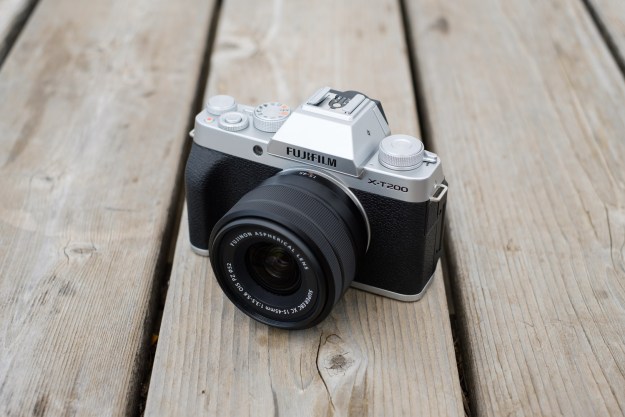
“Whether you’re a pro photographer or one that never moves out of automatic mode, the Fujifilm X-M1’s image quality will astound you.”
- APS-C X-Trans CMOS sensor
- Excellent stills
- Good for both experienced and new users
- Top video quality is only 1080/30p
- Focusing not super fast
- No remote control via app
Fujifilm, like other camera makers, aren’t doing so hot in the low-end, but its advanced X-series cameras are a hit. From the debut of the high-priced X-Pro1 to the relatively affordable X-A1, this selection of cameras offers the tweaks and quality serious photographers want – and many are willing to pay the price. The X-M1 is one of the most accessible of the interchangeable lens models at $799, and now we’ll see if it, too, is a winner.
Features and design
The X-series and specifically the X-M1 have very “old-fashioned” styling, but they all have the latest technology including advanced sensors and, in the case of the X-M1, Wi-Fi for sharing your images via a smartphone. Available in three styles – all-black, the “classic” silver-and-black, and tan-and-silver – the X-M1 has a nicely textured surface and small-bump grip. It’s not as easy to hold as a DSLR but it’s much lighter, so this thin grip is hardly an issue. The camera weighs slightly less than 12 ounces (body only) and measures 4.6 x 2.6 x 1.5 inches. Attach the kits lens, however, and you’ll carry this one on your shoulder rather than in your pocket.
The images have a depth that’s close to full-frame cameras but at a much more affordable price.
On the top deck you’ll find the pop-up flash, a hot shoe, two stereo pinhole mics, mode and command dials, combo shutter/power switch, and a FN (function)/Wi-Fi button. You can set FN to your preference; we chose ISO but other options include depth-of-field (DOF) preview, image size, dynamic range, and many others. If you press this button while in Playback mode, your Wi-Fi menu appears. Connecting your smartphone to the camera is a breeze as the Fujifilm Camera Application works well connecting to a variety of social media sites. You can geo-tag your images but can’t use the app as a remote control.
The X-M1 mode dial immediately tells you this camera is for a broad cross-section of shutterbugs since it has everything from smart auto to manual, with settings for filters and specific scene modes. This is very different than another X-series camera we reviewed, the $1,299 X100S which had very few beginner-friendly options. The dial offers Auto; Advanced SR Auto (basically smart auto); PASM; Custom; individual Portrait, Landscape, and Sports scene modes; Scene Position for even more Scene options; and Advanced which gets you to 13 filters and Multiple Exposure modes. Fujifilm’s menu system is very linear but easy to follow, with brief identifying captions. The bundled owner’s manual is also nicely done so you can make the most of this CSC.
The back is dominated by the tilting 3-inch LCD rated a good 921k dots. We had few issues with Arizona sunshine but when we did we pressed the Q (Quick Menu) on the back lower right and it brightened the screen. If you need more intensity, you can go into the Menu system. Tilting monitors are very helpful in the field as you can hold the camera over your head or at waist level for different perspectives. The screen doesn’t twist but it’s still a good feature. Above the screen near the hot shoe is a button that opens the flash; moving to the right brings you to a sub-command dial. Below are the classic controls including Playback, a red-dot movie button, white balance, AF/delete, Burst mode, Macro, Menu/OK, Q, and Display/Back. Nothing surprising here – just access to the main shooting controls. We had FN set to ISO and exposure compensation was readily available via onscreen menus, so the important shooting aspects were at the ready.
In the right-side compartment are micro USB and mini HDMI outs, while the left has a tiny speaker. The bottom has a compartment for the battery and SD card.
What’s in the box
Fujifilm supplies the X-M1 body, kit lens, plug-in charger, battery rated a very good 350 shots, strap, and lens cap. You also get a 130-page printed owner’s manual and a disc with MyFinePix Studio ver. 4.2, a RAW file converter (Win/Mac), as well as the owner’s manual in a variety of languages. As always, you should use a high-capacity, high-speed card; Fujifilm recommends Class 10 for best performance.
Performance and use
An important component for the success of the X series is the X-Trans CMOS sensor found in almost all recent models other than the new X-A1. This 16.3-megapixel chip just delivers the goods and by that we mean really fine photographs with depth and color accuracy we’ve come to appreciate. Note: It’s a different chip than the X-Trans CMOS II that offers Hybrid AF on the more expensive and DT Editor’s Choice X100S compact, but even so, you’ll be quite pleased with the results. We’re getting a bit ahead of ourselves so first let’s discuss what’s it’s like using the X-M1.
While it works just fine in various auto modes, you really can get your images to sing if you go beyond those basics.
Our review setup consisted of the camera and kit 16-50mm stabilized lens. The camera has a good, nicely balanced feel with key controls readily available. The X-M1 comes to life quickly and then it’s just a matter of framing your subject with the zoom and off you go. We did our turn through the mode dial with the camera set to maximum resolution – 4896 x 3264 pixels for stills, Full HD 1080/30 fps for videos. Since we already had the Fujifilm Camera Application on our Droid 4, synching was fast. With this enabled we could transfer images to the phone, then post to Facebook or whatever. Fujifilm has done a good job with Wi-Fi but the app won’t let you control the camera and there’s no NFC connectivity. They’re not deal-breakers but competition like the new 16-megapixel Sony NEX-5T has these features ($700 with similar 16-50mm OIS lens).
We used the X-M1 over the course of several weeks, shooting a variety of scenes and lighting conditions in the Arizona area. Along with the basic auto modes we played with the various effects and Fujifilm’s variety of film simulations – Provia, Velvia, Astia, and others – that give images decidedly different tones. When our various sessions were completed, pixel-peeping was done on a 27-inch monitor.
At this point, we’ll spare the suspense – the Fujifilm X-M1 is an excellent camera. While it works just fine in various auto modes, you really can get your images to sing if you go beyond those basics – if you don’t want to, we won’t hold it against you. We thoroughly enjoyed using this camera even though it does sound clunky if you’re bracketing your shots; even though this is a mirrorless camera, it makes a “slapping mirror” sound effect when you bracket shots or shoot a burst of photos. It’s a little disconcerting but not the end of the world.
A confession has to made at this point: Long-time DT readers know we’ve always been fans of Canon compacts and DSLRs for their overall tone and feel; the colors just appealed to us. After using several Fujifilm cameras with the X-Trans sensor, we have to admit liking the results much better. Just check out the samples and you’ll see what we mean. The images have a depth that’s close to full-frame cameras but at a much more affordable price. No, we’re not saying they’re as equally fine as those from a $3K Sony RX1 but they’re quite good.
During our travels we shot many different subjects, particularly enjoying the results from a sculpture display and even the fun colors of a Halloween display. The X-M1 captured those hues just like reality, which is exactly what you want from any camera. During our pixel-peeping, we really enlarged many of the images in a big way and they held up and looked just fine.
The X-M1 has a basic ISO range of 200-6,400 with 100 and 25,600 available at the extremes. Forget 25,600 as only a full-frame DSLR could deliver acceptable results at those levels – and that’s pushing it even for those pro-level editions. Our test subject held up well at IS0 3,200 and you can get away with close to 5,000, with images falling apart with noise and color shifts beyond that. It’s impressive to that point just like the optical image stabilization of the supplied kit lens. Given everything, you should be able to grab non-blurry photos in low light, which is all you can ask for.
If there’s one area that’s really lacking, it’s video quality. The top level is 1920 x 1080 at 30 fps. Overall quality is decent with little rolling shutter and moiré but Full HD at 60i should be the baseline in 2013 –especially when many models offer 60p. Also, you can only grab 14-minute movies versus 29 for many other cameras but we doubt this is a problem in the real world since most people take short clips. We’re just noting it for the record. We also should state the camera does not have the super-fast focusing of the X100S since it uses Contrast Detection rather than the Hybrid AF of the more expensive model. Again it’s not a deal breaker since overall the camera is a winner.
Conclusion
Call us fans of new Fujifilm cameras such as the X-M1, especially those using variations of the X-Trans CMOS APS-C sensor. We really like the image quality – the photos are just plain good. Specific to our review sample, it has all the tweaks serious photographers look for and it’ll work just fine for those who don’t want to do a lot of fiddling with dials and menus. As such it’s a Digital Trends Editor’s Choice. That said we really want to test the new Sony NEX-5T to determine which of the two very similar CSCs is the standout. The slightly less expensive Sony has a tilting touchscreen, is a bit more compact, has a supplied add-on flash rather than integrated plus it takes AVCHD 1080/60p video. Even if you can’t wait for our thoughts on the Sony, by all means go ahead and buy the X-M1 – the image quality won’t disappoint.
Highs
- APS-C X-Trans CMOS sensor
- Excellent stills
- Good for both experienced and new users
Lows
- Top video quality is only 1080/30p
- Focusing not super fast
- No remote control via app
Editors' Recommendations
- Fujifilm’s most-hyped camera has just started shipping
- Fujifilm’s GFX 50S II is the cheapest medium-format camera ever
- The best mirrorless cameras
- The best digital cameras
- Fujfilm X-T200 vs. Fujifilm X-T30: A close call











